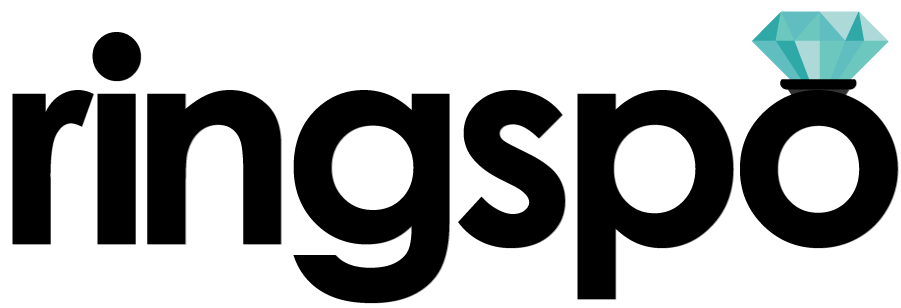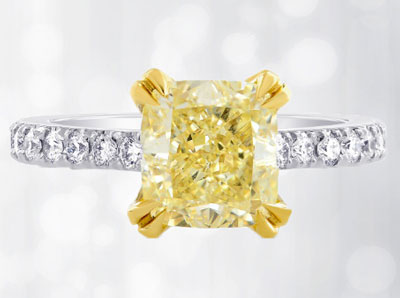Yellow diamonds
How to get the most beautiful yellow diamond and the best value
Ringspo is reader supported
Ringspo is reader-supported, which means we may receive a commission if you click a link to a retailer & subsequently make a purchase.
We feature links to several retailers to help readers find the one that is the best fit for them. Find out more about how Ringspo works here.
Yellow diamonds are a fantastic choice for an engagement ring or any other jewelry.
But buying a yellow diamond can be difficult – there are huge variations in the price and it can be difficult to understand why.

In this article you’ll learn:
- What yellow diamonds’ color descriptions really mean
- Why some yellow diamonds are graded the same but cost radically different amounts
- How to choose a setting that allows the yellow diamond to look as beautiful as possible
What are yellow diamonds?
Yellow diamonds are formed completely naturally – they aren’t just ‘regular’ white diamonds which been treated in some way to change their color to yellow.
In fact, diamonds naturally come in a range of colors, which are known as ‘fancy’ colors. Fancy colors include orange, pink, blue, green and more.

Yellow diamonds are those that have colors that are more yellow than ‘Z’ on the normal diamond color scale:

At this point, the grading of yellow diamonds’ color uses a completely different scale, which we’ll learn about shortly.
What makes yellow diamonds yellow?
Yellow diamonds are formed the exactly the same way as regular white diamonds – by great heat and pressure in the earth.
The difference is that a higher level of nitrogen was present when the yellow diamond was formed, which gave yellow diamonds their color.
In fact, nitrogen is also present in most white diamonds, which results in the increased level of ‘warmth’ for white diamonds as you progress along the diamond color-scale, from D to Z. The more nitrogen present in a diamond, the more yellow it is.

However, while the price decreases as you progress from D to Z on the regular diamond color grading scale, when you go past Z and the yellow color becomes a more distinct and obvious shade of yellow, the rareness and desirability of a diamond increases and so too does the price.

How rare are yellow diamonds?
A common statistic given is that for every 10,000 carats of diamonds that are mined, just 1 carat is a ‘fancy’ colored diamond.
And, for every 100 carats of fancy color that are mined, 85 carats will be brown diamonds, 10 carats will be yellow diamonds and the remaining 5 carats will be split between the other fancy colors.
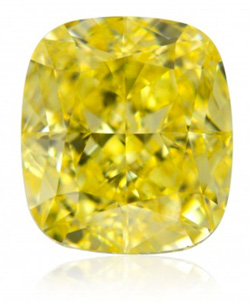
Yellow diamonds are therefore make up just 0.001% of all diamonds mined, and high quality yellow diamonds comprise a much smaller percentage than this. This explains their relative rarity with retailers and the high price per carat when compared with white diamonds, especially for particularly vivid hues of yellow.
A 2004 GIA showed that 46% of yellow diamonds they graded were fancy yellow, 21% were fancy light yellow, 24% were intense yellow, 3% were deep and dark yellow and 6% were vivid yellow.
Are yellow diamonds more expensive?
Fancy yellow diamonds are usually more expensive than white diamonds, but are often significantly less expensive than other fancy colored diamonds:
- A 0.7 carat cushion cut white diamond may be around $1,500
- A 0.7 carat fancy vivid yellow diamond may be around $6,500
- A 0.7 carat fancy gray blue diamond may be around $63,000
- A 0.7 carat fancy vivid pink diamond may be around $80,000
Yellow diamond:

Blue diamond:

Pink diamond:

The images and prices below are courtesy of my recommended retailer for colored diamonds, Leibish & Co.
However, the price of a yellow diamond depends on many factors and some lighter yellow diamonds can actually be less expensive than white diamonds.
Understanding yellow diamonds’ color
Yellow diamonds come in a range of colors:

Much of a yellow diamond’s value, and the price you will pay, is due to the saturation and intensity of its yellow color.
As we found out earlier, only around 0.001% of diamond carats that are mined are yellow colored fancy diamonds, which makes them relatively rare compared to white diamonds.
And, intensely colored yellow diamonds are less common than diamonds with a fainter yellow color, as the conditions to create them were less common when the diamonds were being formed, millions of years ago.
When supply is scarce and demand is high, price increases so the general is that as the level of intensity of yellow color increases, so too does the price.

However, it isn’t quite that simple, as there are other factors that contribute to a yellow diamond’s color:
- Saturation – the intensity of color, from light to vivid.
- Tone – the lightness or darkness of the diamond
- Hue – the dominant color of the stone. As well as the main yellow color, there can can be other ‘secondary’ colors present too.
Understanding how the yellow diamond color scale works can be confusing. Unlike the A to Z scale for white diamonds, it isn’t linear and easy to understand.
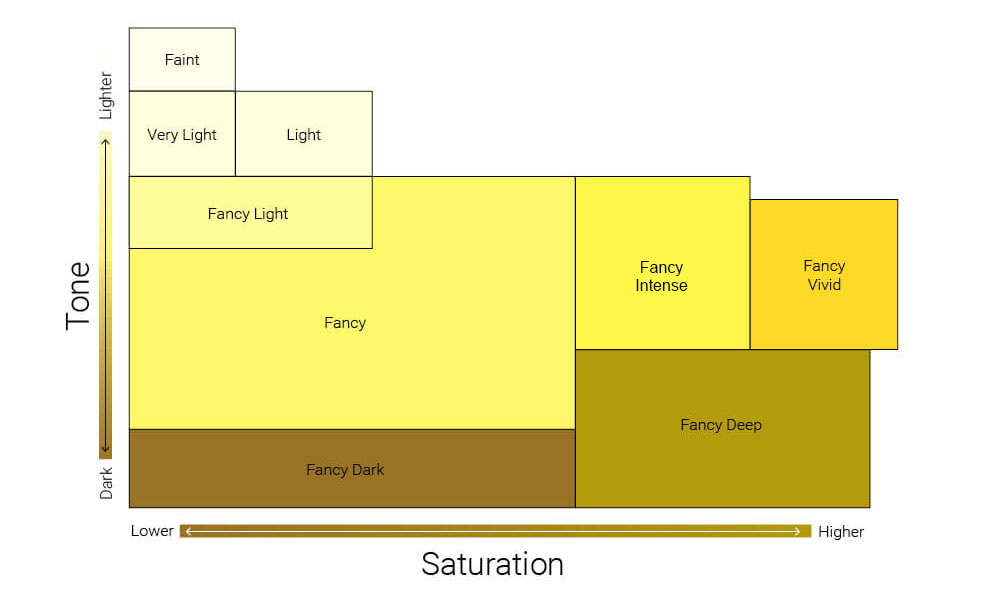
Yellow diamond saturation
Saturation is a measure of how ‘intense’ the color in a diamond is and for yellow diamonds there are 6 grades in the scale. The scale was developed by the Gemological Institute of America (GIA) and is recognised all over the world.
The yellow diamond color intensity scale, from least to most intense is:
- Fancy light
- Fancy
- Fancy dark
- Fancy Deep
- Fancy Intense
- Fancy vivid
Examples of each of the yellow diamond color intensities can be seen below:
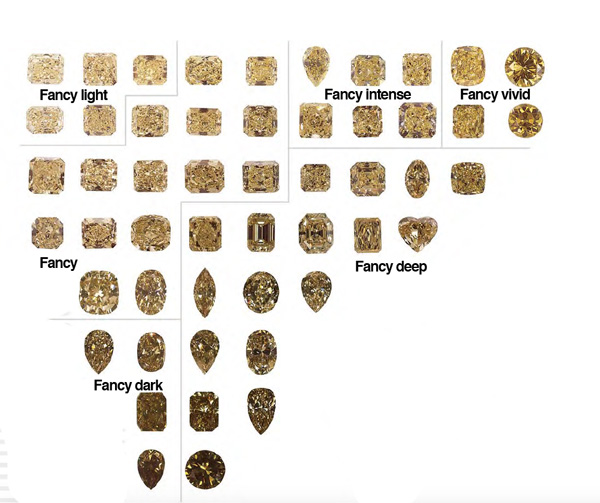
It’s easy to see that within each color grade there can be considerable differences in color due to secondary hues or tone (lightness or darkness of the diamond).
In fact, two diamonds which look very similar can be graded into different color bands, which will result in them being priced very differently.
In the diagram below, ‘diamond’ 1 and ‘diamond 2’ are in the same color grade – ‘Fancy intense’ yellow.

But if we add a third diamond in at the bottom end of the ‘vivid’ yellow intensity, we can see that it will be very close to diamond 2 in color, despite being in different color grades:

The difference in classification would result in diamond 3 being valued considerably higher than diamond 2, even if there was very little visible difference between them.
This can make it difficult for even professional diamond graders to decide on the color grade of a diamond if it is on the border between two of the color grades.
Yellow diamond color grades
We’ll look at each of the yellow diamond saturation color grades in turn, from least intense to most intense.
Fancy light yellow diamonds
Fancy light yellow diamonds are the first grade of stone which are classified as ‘yellow diamonds’, rather than just warmer colored white diamonds.
While their yellow color is faint compared to diamonds further down the intensity scale, this can be boosted by choosing a yellow gold ring setting, or a white-gold ring setting but a yellow-gold ring head.
Although there are many factors that affect their value, they are priced roughly on par with an I color white diamond, at around $3,500 per carat.

Fancy Yellow Diamonds
Fancy Yellow Diamonds are the most common color of yellow diamond and strike a great balance between color and value.
While the yellow color isn’t quite as intense as the grades below, this can again be boosted with a yellow gold setting.
Fancy yellow diamonds are usually around $4,500 – $5,000 per carat.
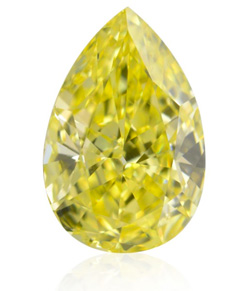
Fancy Dark Yellow diamonds
While they are higher on the intensity scale than ‘fancy light yellow’ and ‘fancy yellow’ diamonds, ‘pure’ dark yellow diamonds don’t exist. Instead, there is usually a strong brown secondary color, which makes the diamond much darker.
Due to the presence of brown in the stone, prices for ‘fancy dark’ yellow diamonds can be lower than for the two previous grades.

Fancy Deep Yellow diamonds
Fancy Deep Yellow diamonds have a darker yellow tone, and again often show a brown secondary color.
Prices can be higher than ‘fancy light’ and ‘fancy yellow’ diamonds, but again it is dependent on the secondary colors present and how dark the diamond is.

Fancy intense yellow diamonds
Fancy intense yellow diamonds are also commonly known as ‘canary diamonds’.
They are the middle-point on the intensity scale for yellow colored diamonds and are the most popular choice.
Due to their popularity, a 1 carat fancy intense yellow will be around $8,000 – considerably higher than a white diamond of the same carat weight.

Fancy vivid yellow diamonds
Fancy vivid diamonds are at the top of the intensity tree and are extremely rare. This rarity means that they are priced extremely highly, although this price is dependant on many factors.
Fancy vivid yellow diamonds often have secondary colors present too, and their tonality (whether light or dark) can affect their price hugely. Depending on the tonality, the price of a fancy vivid can range from around $13,000 per carat for a stone with darker tones, to $18,000 per carat for a one carat stone with the preferred lighter tones.

‘Hue’ and secondary colors
Hue is the dominant color of a diamond which, as we’re looking at yellow diamonds, is yellow. However, many colored diamonds also show hints of a secondary color also, due to the presence of other minerals when where formed.
Yellow diamonds can have secondary colours including Green, Brown, Orange, Gray, Pink, Purple, Violet, Blue and Red. These secondary colors are always included on the grading report:

When looking at a diamond’s color description, the predominant color is always listed last.
The two examples below show the huge difference in price between a yellow-brown diamond and a brown-yellow diamond.
A yellow brown diamond is a brown diamond with a yellow secondary color

A brown yellow diamond is a yellow diamond with brown secondary color.

Secondary colors and their effect on price
There’s a simple rule to remember when judging how a secondary color will affect the price of a yellow diamond:
if the secondary color is the colour of a fancy-colored diamond that is more prized than a yellow diamond then the price will the higher than a pure yellow diamond.
So, pink, orange and green secondary colors will increase the value of a yellow diamond.
Conversely, if the secondary color is a color that is less expensive than a yellow diamond then the price will be lower than a pure yellow diamond. That’s it!
Other considerations when choosing your yellow diamond
The next sections go into more detail about some more minor aspects of yellow diamond color.
If you’re reading this for the first time and just want to get an idea of the factors that go into grading a yellow diamond’s color then you don’t need to read them.
However, if you’re going to be purchasing your yellow diamond shortly, then I recommend that you read them to ensure that you are armed with all of the information you need to make your decision.
Yellow diamond color origin and treatment – click to read
As more intensely yellow colored diamonds are more valuable than lighter yellow diamonds, several techniques have been developed to increase the intensity of the yellow color.
While treatment will improve the color of a diamond, any stone that has been artificially treated will always be considerably less valuable than a diamond of the same color which developed its color naturally.
The most common types of treatment are:
- Irradiation – diamonds are bombarded by radiation which affects their atomic structure and changes their color.
- Coatings – a coating is applied to the surface of the diamond to change its color. While this can initially improve the appearance of a diamond, the coating can change or fade over time due to heat, cleaning with chemicals or just through day to day wear.
- High Pressure, High Temperature (HPHT) – by applying the natural forces that created a diamond (pressure and heat) to a brown diamond, the color can be changed to become yellow. While in the past some unscrupulous dealers sold these as natural yellow diamonds as the treatment was difficult to detect, more advanced detection methods now means that HPHT diamonds can now be identified.
I recommend only purchasing diamonds with ‘natural’ yellow color, so ensuring that a diamond’s color is natural is one of the key things to check for on a grading report (‘also commonly known as a ‘certificate’ or ‘cert’). If the color is natural, this will be shown as ‘Natural’ in the color origin section of the certificate.
If the diamond has had treatments applied to it, the type of treatment will be listed.
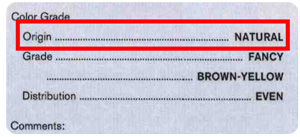
Yellow Diamond Fluorescence – click to read
Fluorescence is a property that some diamonds exhibit when they are exposed to UV light due to trace levels of minerals in their make-up.
This is most easily seen when a diamond is exposed to a UV ‘black light’, where diamonds with high levels of fluorescence will glow like the image on the right.
However, sunlight also contains UV light and some diamonds may have their color adversely affected because of it.
Diamonds are graded for fluorescence using the following scale:
- None
- Faint
- Medium
- Strong
- Very strong
For most colored diamonds, fluorescence is unimportant. Even a diamond with a ‘very strong’ fluorescence grade, which would make a white diamond less valuable, is accepted for most fancy colors.
Yellow diamonds are the exception though, and diamonds graded ‘strong’ and ‘very strong’ for fluorescence should be avoided as there is a distinct possibility that the diamond’s color be negatively affected, or the diamond could have an unattractive ‘milky’ sheen when viewed in sunlight.
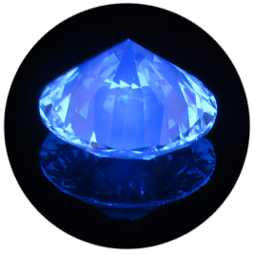
Yellow diamond color distribution – click to read
The distribution, or ‘spread’, of diamond color is a grading of how evenly the diamond’s yellow color is distributed across the stone.
Distribution is categorized as “Even” if it is symmetrical in over 50% of the stone or “Uneven” if it is less than 50% symmetrical.
You can see on the two stones below that there are very distinct areas of light and dark color. Both of these diamonds have ‘uneven’ color distribution.

Color distribution is assessed as part of each yellow diamond’s independent grading and is included on the Grading Report.
A more even distribution of color is desirable, and the cost for diamonds graded uneven is considerably lower than for an even color spread.

Yellow Diamond Cut
Strictly speaking, diamond ‘cut’ is a grading on the quality of how well a diamond has been cut, shaped and polished from the rough diamond to the finished gem.
For white diamonds, diamond’s cut is incredibly important, as it’s the biggest factor in determining how much the diamond will sparkle.

For yellow diamonds though, sparkle is not the defining factor in deciding the quality of the stone. Color is.
For this reason, a diamond’s cut grade is not nearly as important for yellow diamonds and shapes other than round are much more common:

With white diamonds, a ‘fancy shape’ (ie. one other than round) can often increase the ‘warmth’ of the color – making the stone look less white and more yellow. This is undesirable for white diamonds, where most people want their stones to be as white as possible.
However, the aim of yellow diamonds is to have as intense a color as possible, so the added ‘warmth’ that a non-round shape adds is a positive, rather than a negative.
In a study of over 24,000 diamonds conducted in 2004, the GIA found that the most common diamond shape for yellow diamonds was radiant, with oval, princess cut, pear and cushion all also popular.
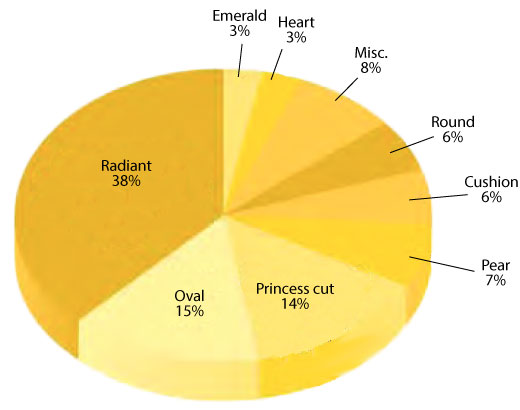
Yellow diamond shape and its effect on color
How a diamond is cut and shaped can have a big impact on the color of the final stone: cutting a diamond deeper means that less light can pass through it, which increases the intensity of color.
All of the diamonds below were cut from the same rough diamond, which had a uniform color.

The wide range of yellow intensities shows the large difference that the diamond cut can make. The lighter diamonds are all much shallower than the larger, deeper diamonds, which results in the radically different colors.
Yellow Diamond Clarity
As diamonds are formed through natural processes, almost all of them have some inclusions or ‘flaws’ present. These are microscopic particles of materials that were present when the diamond was formed and are graded on a scale from ‘flawless’ to ‘included’:
Example inclusions include
Cloud inclusion
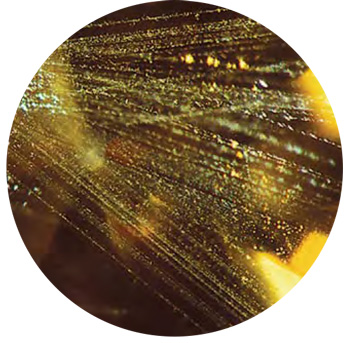
Crystal inclusion

With white diamonds, the most important thing to ensure is that a diamond is ‘eye clean’ ie. no inclusions can be seen with the naked eye. This level of clarity is generally reached at VS2 on the clarity scale, and choosing a clarity above VS2 means that buyers are paying for an increase in quality that can’t actually be seen.
As with cut, the rules for clarity are a little different with yellow diamonds than white diamonds.
Due to the small number of yellow diamonds available, the high demand and the focus on color as the most important factor in deciding a diamond’s value, small visible inclusions are not necessarily a deal breaker for all buyers.
Each diamond’s grading report will have a ‘clarity plot’, which shows where the inclusions are located on the diamond:

Ideally you should avoid diamonds which have significant inclusions under the top ‘table’ of a diamond, as in the clarity plot above, as they are easier to see there:

However, if you are prioritising color then you may need to make some sacrifices with inclusions.
Yellow Diamond Carat
All things being equal, a larger diamond of any one color will be more expensive then a smaller diamond of the same color.
But, smaller, more intensely colored diamonds may be significantly more expensive than larger, fainter diamonds.
$17,000 could buy a 2.69 carat ‘fancy light’ yellow diamond:

The same budget would only stretch to a 1.04 carat ‘Fancy vivid’:

To match the original carat weight of 2.6 carats with a fancy vivid yellow color would cost over $72,000:
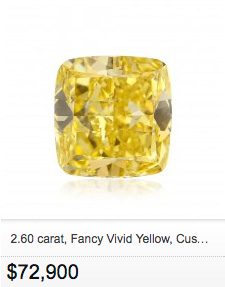
The difference is because of the huge variation in ‘price per carat’ that color and quality can make to a yellow diamond.
Finding the right balance of color intensity and carat weight is key. The best way to do this is to find a retailer that has a wide selection of yellow diamond available for you to compare so that you can find the diamond that strikes the right balance for you.
Ring settings and their effect on diamond color
An ‘unset’ diamond ie. one that has not yet been mounted in a ring setting, can look very different to one that has been mounted.
With white diamonds, the color or ring setting can make a big difference to the color. a yellow gold setting can make even an extremely white diamond look much yellower than it is. For white diamonds, this is undesirable.
However, for yellow diamonds, the fact that a gold ring setting can increase the intensity of a yellow diamond considerably is definitely a desirable trait.
If you want a white-colored engagement ring setting (e.g. white gold or platinum), a good solution to ensure that you benefit from the increase in color intensity that yellow gold offers is to choose a setting which has a yellow gold prongs and ring head.

This will ensure that your yellow diamond benefits from the increase in yellow intensity that yellow gold offers, but the ring setting will still look predominantly white.
Yellow Diamond Choice and Selection
Because yellow diamonds are so rare, bricks and mortar jewelers are likely to have a VERY limited selection, which means that it is difficult for buyers to compare colors, quality and prices.
This is where online jewelers really come into their own, giving you a huge range of choice.
My recommended jeweler for high end yellow diamonds is Leibish & Co., who are colored diamond specialists and who will have several thousand yellow diamonds in stock at any one time with a range of colors, shapes and prices. This allows you to compare a range of different stones and find the one that is perfect for you. You can check out their current selection of yellow diamonds here.
James Allen are a great choice for more attainable yellow diamonds, and you can see their selection here.
While it’s important to get the best diamond that you can for you ring, in some ways it’s the setting that really defines the character of the ring.
This examples below are by no means a definitive list, but are a representation of some of the most common styles of settings that most jewelers will have available.
Each of these settings are available at Leibish & co.
Solitaire yellow diamond ring
The classic solitaire is still the most popular ring style. It suits any diamond shape and its simplicity means that it is exceedingly budget-friendly. Solitaires are a great choice to ensure that as much light can enter your diamond as possible, meaning that it will sparkle as brightly as possible.
As with this example, if you are choosing a white-colored band, ensure that the ring heat and prongs are yellow gold will increase the intensity of your yellow diamond.
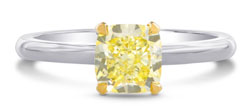
Three stone yellow diamond ring
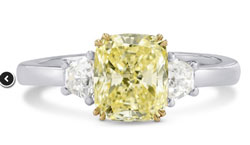
Adding side stones are a great way to support a center stone, and the white trapezoid diamonds used on this ring will add some impressive sparkle to the ring to ensure that it can be seen from across the room!
A side stone setting is more expensive than a solitaire, but some of the increase in budget can be reclaimed by going for a slightly smaller center stone, since the center stone no longer has to do all of the impressing on its own.
Side stone yellow diamond ring with pink side stones
Side stone rings can also be a great way of incorporating other fancy colored diamonds.
This ring uses six smaller pink diamonds for a total side stone carat weight of 0.14ct, which is a much more budget-friendly way of incorporating pink diamonds than two 0.7carat would be.


Pavé settings up the level of bling considerably by adding ‘micro’ diamonds to the ring band.
This ‘split shank’ pavé setting (shank is another word for the band of the ring) makes for a modern and sleek yellow diamond engagement ring.
Halo yellow diamond ring
Halo settings are a great way of maximizing the visual impact of a ring, as the stones surrounding the center stone catch the light and add their sparkle.
It can also be a great way to increase the size of a ring, meaning that a smaller, less expensive center stone can be chosen.
The angular halo and baguette diamond side stones give this ring a classic, art deco feel. .

Yellow gold yellow diamond ring

While white colored settings are chosen for around 75% of engagement rings, yellow gold settings complement yellow diamonds exceptionally well.
Pairing a yellow diamond engagement ring with brilliant cut white diamonds is a great way of combining the beauty of a yellow diamond with the brilliance and sparkle of well-cut white diamonds.
Recommended Retailers
Buying a yellow diamond engagement ring is a specialised purchase, and not one that many retailers are properly equipped to help you with.
Finding the right diamond for your ring that matches your preferences for color, shape and quality necessarily involves being able to review a wide selection to find the stone and ring setting that is perfect for you. Very few retailers have the breadth of choice of high quality yellow diamonds to allow you to do this.
I have two recommendations, depending on your budget:
Accessible yellow diamonds
James Allen is my #1 recommended retailer across all diamond categories because of their wide selection of high quality stones, fair prices and excellent service.
While they may not have quite as many yellow diamonds as white diamonds, they usually have around 3,000 available to choose from at any one time, so there should be something to cater to most needs.
Check out James Allen’s selection of yellow diamonds here.

High-end yellow diamonds:
Leibish & Co. is a family-owned jeweler which specialises only in colored diamonds.
Leibish has hundreds of diamonds in stock at any one time, each with high quality images from several angles so you can se exactly what you are buying. As a diamond dealer, rather than just a consumer retailer, Leibish’s direct supply chain also means that their prices are extremely competitive.
Check out Leibish’s selection of yellow diamond engagement rings here.
